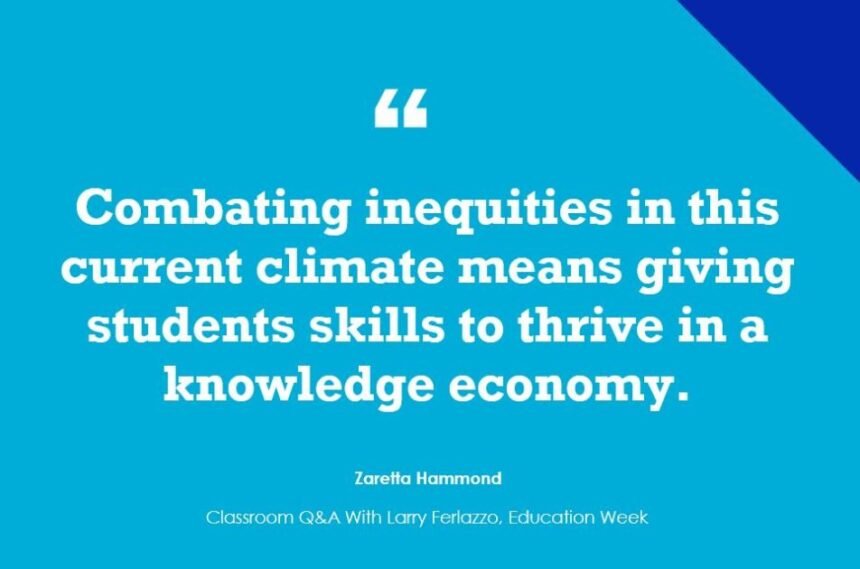
Teacher educator, independent researcher, and author Zaretta Hammond has a new book out, Rebuilding Students′ Learning Power: Teaching for Instructional Equity and Cognitive Justice, which builds on previous work to enhance the student learning process. She recently chatted with me about the new book.
LF: Your first book, Culturally Responsive Teaching and The Brain, has been both very popular and influential. You characterize that book as offering a “conceptual” understanding of what is needed for instructional equity and this new book as more of a “how-to.” Could you elaborate a bit on why you think a follow-up “road map” was needed?
We need an instructional road map as we continue to address the challenges of learning loss from the pandemic and the reality before the pandemic: that too many of our students were compliant learners with growing learning gaps. School closings during the pandemic only exacerbated this chronic situation.
We must figure out how to help students get more than a year’s academic growth in a year’s time. That’s what I mean by instructional equity. I felt we needed a road map and a playbook to show educators how to help students grow their learning power, not provide more teacher-centered strategies that never make it into the hands of students.
It taps into a key principle of cognitive neuroscience—the brain’s malleability, or what researchers call neuroplasticity. But only the student can do that. The teacher is just the facilitator, like a personal trainer. That is why I wrote Rebuilding Students’ Learning Power.
I wrote Culturally Responsive Teaching and the Brain to help educators understand what culturally responsive teaching was and wasn’t. I wanted people to understand its potential to turbocharge our instructional practice and to know it isn’t all about DEI topics in the curriculum.
Unfortunately, that is how some characterize culturally responsive pedagogy. They tend to focus on (and misunderstand) the culture part, thinking that’s some euphemism for talking about diversity. They don’t recognize how the “responsive” part connects to operationalizing the science of learning during instruction by using feedback and metaphors, etc., that the learner’s brain recognizes, making learning new content easier.

LF: You’ve described the “science of learning as an antidote to inequity.” I’ve heard various definitions of the “science of learning.” What would you say are its most important elements?
Yes, the idea of the science of learning is becoming very popular these days. I’ve been talking about the science of how the brain learns since 1999, before it was even called the science of learning. I define it very simply—the scientific knowledge about how the brain learns, and to use that knowledge to facilitate learning, which is characterized as a change in conceptual understanding or skill development that allows the learner to handle more complex content or skills.
Linda Darling-Hammond and her colleagues at Learning Policy Institute created the Science of Learning and Development Alliance that brought together educators, researchers, and cognitive scientists to summarize findings into eight pillars. There are three that I think are most important.
- Integration. The idea that learning involves our emotions, relationships, and context, as well as academic content.
- Malleability – The idea that the brain is a learning machine that grows its own intelligence, like muscles grow through challenge.
- Meaning-making. The brain is a meaning maker. Learning happens when we build schema and make connections between experiences. This ability is what turns inert, random information into usable knowledge.
LF: OK, you’ve defined the science of learning. Can you describe how and why educators should view it as a strategy to “build student learning power” and equity, and, while you’re at it, define the term you use, “cognitive redlining”?
Well, first it is important to point out that the science of learning isn’t a “strategy” per se but a codification of key principles of learning. It’s similar to Rosenshine’s 10 principles of instruction. But where Rosenshine’s principles focused on what the teacher is doing, I try to help teachers understand what the body of knowledge we call the science of learning has to say about how the learner’s brain learns through information processing.
The majority of the strategies and tactics in the book center around helping students improve their information-processing ability, since it is the cornerstone of building one’s cognitive abilities. We often get this confused with executive functioning, but it comes before executive functioning in a way.
When we think about how we can address inequity in schools, we need to break down the processes like a pedagogy of compliance, focused on having students be compliant rather than curious learners.
The late education guru and former award-winning superintendent, Phil Schlechty, wrote about this over a decade ago in his seminal piece, Engaging Students: The Next Level of Working on the Work (2011), where he laid out the levels of engagement and compliance. More than about social engagement, he was making a connection to cognitive engagement as well.
Over time, the pedagogy of compliance underdevelops students’ cognitive capacity. This leads to what I term as “cognitive redlining,” a type of tracking and sorting based on cognitive readiness. The only way to break through this phenomenon is to help students become engaged, proficient learners.
LF: In the book, you offer a substantial number of suggested strategies for teachers to use, yet you want the priority to be “supporting students to actually manipulate their learning.” Can you talk about what you mean by that?
Here’s a key thing for us educators to remember: Only the learner learns. That may sound cryptic, but it is the reality of teaching and learning. Just because we taught something doesn’t mean that the student learned it.
Learning is an active process. It requires two key ingredients—productive struggle and metastrategic thinking—among other things. These two play a central role in helping students turn random facts and figures presented in lessons into usable knowledge. But to make this happen, students have to not just be metacognitive and think about their thinking but must be able to change their learning moves. That’s metastrategic thinking.
To actually build this new learning and background knowledge, students must be able to change their learning moves to improve their conceptual understanding or skill development. Think of it like an athlete who reviews his game tape to see what moves he needs to correct in his three-point shot or in her soccer goal blocking. This is what Ron Ritchhart of Making Thinking Visible (2014) and Culture of Thinking In Action (2023) calls being metastrategic, which is different from being metacognitive. In the book, I share what the key differences are and how both are needed.
LF: In many communities, it may be even dangerous for teachers to talk about inequities in today’s political climate. What would you say to educators who want to combat them and also don’t want to get fired?
Well, the book is centered around the science of learning, not DEI topics. So when I say “instructional equity,” I am referring to making sure all students get access to powerful teaching that coaches them to become powerful learners.
Now, I do set the context with what has historically created these conditions of underdeveloped cognition for some groups of students. This isn’t a book about inequities. Just the opposite; it is about the pedagogy of possibility as the remedy is helping students become craftsmen of learning, not talking about inequities.
So, nowhere in the book do I advocate talking about inequities or racism to students. Actually, that can be a distraction for some schools. They never get around to improving instruction that helps students develop the skills of a powerful learner and a good information processor.
Combating inequities in this current climate means giving students skills to thrive in a knowledge economy where they have to know how to read proficiently and can make sense of content, a place where knowledge becomes obsolete at an accelerated rate. Teaching strong learn-how-to-learn skills is not banned. That’s actually our job as educators.

LF: Is there anything I haven’t asked you about that you’d like to share?
Helping students become powerful learners means we have to build our capacity to become the “personal trainers” of students’ cognitive development. So, we have to build our skills and capacity around instruction rather than just seeking engagement.
Engagement doesn’t automatically equal learning if the student doesn’t have well-developed information-processing skills. Rebuilding Students’ Learning Power lays the foundation to address both teaching and learning in practical ways.

LF: Thanks, Zaretta!
Readers might also be interested in these previous related posts:
‘Culturally Responsive Teaching’: An Interview With Zaretta Hammond
Making Culturally Responsive Teaching Work: Zaretta Hammond Corrects 3 Big Misconceptions
Zaretta Hammond: 6 Ways to Uphold Culturally Responsive Teaching







